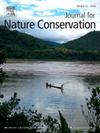IF 2.2
3区 环境科学与生态学
Q2 BIODIVERSITY CONSERVATION
引用次数: 0
摘要
湖泊的自然水文节律对水鸟的聚集起着至关重要的作用。然而,人工控制的闸控湖改变了天然湖泊的水位波动,影响了水鸟群落的多样性。武昌湖是长江中下游洪泛区的一个闸控湖,是东亚-澳大利亚航道上水鸟的重要越冬地。2021-2022 年越冬期的湖泊水位控制与 2022-2023 年不同。我们收集了两个越冬期的水鸟数据,基于功能α、β多样性和水鸟功能群,分析了水位调节对越冬水鸟群落的影响。通过觅食栖息地的遥感数据,我们进一步分析了不同水位下栖息地结构变化对水鸟群落的影响。结果表明,湖水水位高时,以鱼类为食的深水泅水鸟(G3)和以种子为食的泅水鸟(G7)数量显著增加,以鱼类为食的大型涉禽(G2)数量显著减少。而湖水水位过高则降低了功能丰富度指数(FRic)、功能均匀度指数(FEve)和功能分化指数(FDiv)。其中,2023 年 1 月和 2 月,功能分异指数明显下降。功能贝塔多样性分析表明,2022-2023 年群落间的总相似度明显下降,功能嵌套度分量在 10 月和 2 月明显增加,功能周转率分量在 10 月、12 月和 2 月明显减少。广义线性混合模型(GLMM)显示,高湖水位扩大了水域面积,有利于游泳鸟类的栖息,同时减少了泥滩面积,限制了涉水鸟类的栖息空间。相反,湖泊水位下降则增加了泥滩面积,促进了群落间的差异。该研究分析了水位、栖息地和水鸟之间的耦合关系,结果表明适当的湖泊水位调节是保护水鸟的有效方法。它为湖泊湿地管理和水鸟保护提供了科学信息。本文章由计算机程序翻译,如有差异,请以英文原文为准。
Effects of high water levels on waterbird diversity at Wuchang Lake, a gate-controlled lake in the middle and lower Yangtze River floodplain, China
The natural hydrological rhythms of lakes play a crucial role in the aggregation of waterbirds. However, artificial controls of gate-controlled lakes alter water level fluctuations in the natural lakes and affect the diversity of waterbird communities. Wuchang Lake, a gated-controlled lake in the middle and lower Yangtze River floodplain, is an important wintering site for waterbirds on the East Asian–Australasian Flyway. Lake water level control during the wintering period in 2021–2022 was different than that in 2022–2023. We collected waterbird data from two wintering periods, based on functional alpha and beta diversity and waterbird functional groups, we analyzed the impact of water level regulation on wintering waterbird communities. By remote sensing data of foraging habitats we further analyzed the effects of changes in habitat structure to waterbird communities at different water levels. The results showed that during high lake water level, the numbers of deep water swimmers feeding on fish (G3) and swimmers feeding on seeds (G7) increased significantly, the number of large wading birds feeding on fish (G2) decreased significantly. And high lake water level decreased functional richness indices (FRic), functional evenness indices (FEve) and functional divergence indices (FDiv). Among them, in January and February 2023, the functional divergence indices significantly decreased. Functional beta diversity analysis showed that the total dissimilarity among communities decreased significantly in 2022–2023, with the functional nestedness component increasing significantly in October and February and the functional turnover component decreasing significantly in October, December, and February. Generalised linear mixed models (GLMM) showed that high lake level expanded the water area and favored the habitat of swimming birds, while decreased mudflat area, limiting the habitat space for wading birds. In contrast, lake water level decreased to increase the mudflat area and promoted the differences among communities. This study analysis a coupling relationship among water levels, habitats, and waterbirds, the results show that appropriate lake level regulation is an effective method to protect waterbirds. It provides scientific information for the lake wetland management and waterbird conservation.
求助全文
通过发布文献求助,成功后即可免费获取论文全文。
去求助
来源期刊

Journal for Nature Conservation
环境科学-生态学
CiteScore
3.70
自引率
5.00%
发文量
151
审稿时长
7.9 weeks
期刊介绍:
The Journal for Nature Conservation addresses concepts, methods and techniques for nature conservation. This international and interdisciplinary journal encourages collaboration between scientists and practitioners, including the integration of biodiversity issues with social and economic concepts. Therefore, conceptual, technical and methodological papers, as well as reviews, research papers, and short communications are welcomed from a wide range of disciplines, including theoretical ecology, landscape ecology, restoration ecology, ecological modelling, and others, provided that there is a clear connection and immediate relevance to nature conservation.
Manuscripts without any immediate conservation context, such as inventories, distribution modelling, genetic studies, animal behaviour, plant physiology, will not be considered for this journal; though such data may be useful for conservationists and managers in the future, this is outside of the current scope of the journal.
 求助内容:
求助内容: 应助结果提醒方式:
应助结果提醒方式:


